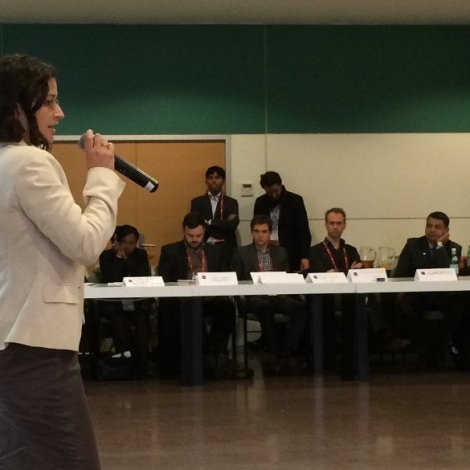The GSM Association’s Mobile World Congress in Barcelona this year featured a breakout roundtable on the new role of mobile devices in energy and water services access. GSMA’s congress is the largest annual mobile industry event in the world, and this session featured updates on the industry’s future in easing access to services in both rural and urban communities.
Hélène Smertnik, Market Intelligence Analyst for GSMA Mobile for Development, shares these notes from the roundtable.
“The Changing Role of Mobile in Extending Access to Energy & Water Services” Key messages of GSMA Mobile Enabled Community Services roundtable at MWC 2014
The Mobile Enabled Community Services (MECS) Energy-Addressable Market
Of the 1.2 billion people who lack energy access worldwide, 643 million have mobile coverage.
Energy access is a big-scale problem with small-scale solutions.
Geographical spread
They represent an “energy-addressable market” that presents an interesting geographical spread. According to the GSMA’s calculations, these are the people worldwide who are covered by the GSM network but who do not have acces to basic energy service.
- In sub-Saharan Africa there are 359 million people.
- In South Asia the market is evaluated at 175 million people.
- In Latin America and the Caribbean, 15 million people have access to the GSM network but no electricity.
From rural to urban
Rural underserved communities have poor or non-existent, inconvenient and very expensive energy, and urban underserved communities have access to cheaper grid energy that is not reliable.
Small-scale solutions work
Energy access is a big-scale problem with small-scale solutions. In Africa, the costs of electricity can be as high as US$.36/kWh while in the US, electricity is one-third of the cost at US$.12/kWh.
Roar Bjærum, Head of Easypaisa at Telenor Pakistan, highlighted the fact that less than 70 percent of the population had access to the grid and those that are connected face blackouts of 10 to 12 hours without electricity. In view of this challenge, Telenor Pakistan’s mobile money platform, Easypaisa, has launched a project with the support of a MECS Innovation Fund Grant. It offers an affordable solar energy service for the country’s underserved population through an Islamic leasing model.
He emphasized that there is still a way to go, as the sector is small and new, to attract bigger companies and investments.
The MECS Water-Addressable Market
Of the 780 million people worldwide who lack access to clean water, 263 million have GSM coverage.
Geographical spread
The “water-addressable market” includes people without access to improved water sources but within GSM network coverage. This is how it is distributed.
- It is largest in sub-Saharan Africa at 125 million people.
- Followed by South Asia, with 50 million people
- Latin America and the Caribbean have 12 million people still lacking access to improved water while being covered by the GSM network.
From rural to urban
Improved water sources in rural areas are often unreliable, alternative sources are often unsafe and inaccessible. In urban areas, water services are generally intermittent and expensive to buy in small quantities
Water, a new MECS market
The water sector is just beginning to adopt mobile technology to improve delivery and gather and provide information for remote and underserved communities. For example, mobile devices can give the location of water agents in a community or of functioning wells or other water points. However, MECS highlighted the need to better inform water service providers about the capabilities of mobile.
Jack Beach, advisor at Living Water International, has partnered with Portland State University to conduct a national level roll out of cellular reporting sensor on hand pumps in Rwanda. They plan to install 200 sensors by the end of 2014. The sensors may help lower the cost of delivering water by reducing operational downtime across hand pump programs. This project had strongly benefited from the backing of the government of Rwanda.
Overcoming MECS challenges
It is not about the technology but the partnerships. Doing the technology right is the easy part, but getting mobile network operators to buy in takes lots of effort.
Government support can also play a role in deployment and capacity building and this holds particularly true in the water sector. The sector often receives subsidies by donors and governments. Although the engagement of the government is necessary, apparently it is difficult. Only 13 percent of 167 MECS Innovation Fund proposals suggested the government as a partner.
Utilities are also an interesting partner for the mobile network operators and service providers who are working on scaling up micro solutions, says Jason Simpson a regional director of Cable & Wireless Communications. This partnership opportunity is big, although still very rare.
The right investment to scale
Energy and water services are capital intensive and capital is hard to find. That is why grants are still needed to generate data and track records to start talking about debt finance. Costs need to remain low and there should be a focus on volume, says Anil Raj of OMC Power. There is a need to move beyond research and development, and “cracking the code,” to create solid, scalable business models. There is a growing acceptance that mobile network operators have a role to play in order to grow the sector. Impact investors cannot do it all on their own.
Usage of data
Machine-toMachine (M2M) provides key data on how customers are using their solar-powered home systems, which is necessary for the success of the systems in the long term, says Davidi Vortman of Nova Lumos.
Focusing on data-driven management will reduce risk in the market by gaining an understanding of credit risk and customers’ behaviour, says Josephie Ragni of the Netri Foundation.
For more information please see GSMA’s report, Sizing the Opportunity of Mobile to Support Energy and Water Access, and also GSMA’s Web site.

